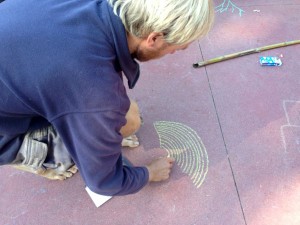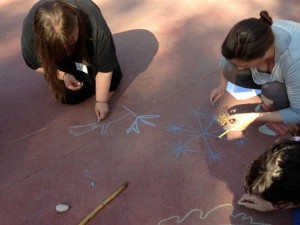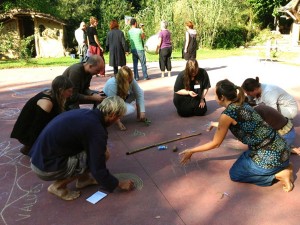(Note: This session would be best to give early in a PDC. The session plan for this session can be found at the bottom under “Resources”)
Time needed: Best as a one-hour session, possibly longer. It can be flexible to fit the time available. Introduce the topic of patterns to the class and state why it is important in Permaculture. Invite the group to step up to the square paper sheets (different sizes) and ask how many times they can fold in half. Keep going until you can’t go further. Ask if there are any common experiences?
Related video
How many times could you fold the sheet of paper? (each group folded 6 or 7 times). Impossible (perhaps) to fold more that 8 times. As this is a session on patterns look for universal patterns that we can understand, modify and create.  Introduce definition (from Wikipedia): “A pattern is a theme of recurring events or objects with elements repeated in a predictable manner with predictable outcomes.” In our example with paper squares:
Introduce definition (from Wikipedia): “A pattern is a theme of recurring events or objects with elements repeated in a predictable manner with predictable outcomes.” In our example with paper squares:
- Recurring object – pieces of paper
- Element repeated – fold
- Predictable manner – always fold in half
- Predictable outcome – number of possible folds
- Visible Patterns
- Invisible Patterns
- Individually explore the natural patterns in objects the group have found in nature and draw the pattern found in the natural object. Use chalks on big pieces of paper or on the floor.
Try to scale it up or turn 180 degrees around. Try both. Repeat repeat repeat! Try to make smaller. See the repetition in the pattern. Have a look at other people patterns, can we see similarities?  What are the names of the patterns we find in nature? Can we name our patterns?
What are the names of the patterns we find in nature? Can we name our patterns?
- Branching
- Scatter
- Lobe
- Spiral
- Net
Ask if these patterns remind you of anything else in nature? i.e. Snowflakes ; Branching – The blood veins in our body. Show how patterns can be repeated at different scales and introduce that these patterns recur at the smallest and higher levels. Invite the group to get into pairs. Ask the first person to draw the pattern and invite the partner to repeat by following the movement of the partner’s hand. Its okay if they overlap or get bigger or smaller, keep repeating the pattern.
What do we learn about patterns?
Proportions keep changing but shape remains the same. Invite the group to go for a walk together to see where we can see the patterns demonstrated in nature. Shared walk and discussion. (½ an hour.) Bring the group back together and split the group up to smaller groups. Give each group one or more patterns and invite them to explore the following questions, each one on a separate card:
- What is the function of the pattern?
- Where do we see this pattern in nature?
- Where is this pattern used in human design or Permaculture design?
Get each group to feedback. Close with everyone giving feedback and link with the later session on pattern language. Give out the handout for Patterns in Nature.
Resources:
- Session Plan for this session to download
- Fundamental Patterns (reproduced from The Permaculture Activist #39)
- Patterns in Nature (reproduced from The Permaculture Activist #39)
- Book recommendation: Nature by Numbers
